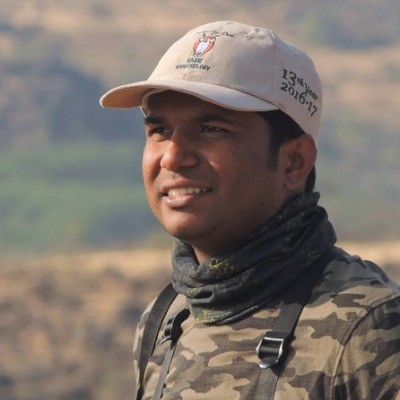Mayureshwar
It might be India’s smallest sanctuary, but it offers a big opportunity to sight the Indian Wolf. And much more
Rudraksha Chodankar | Sandip Telang
The Indian Wolf is threatened by severe habitat loss.
Mayureshwar Wildlife Sanctuary
Situated in Tehsil Baramati, around 70km from Pune, is the smallest wildlife sanctuary in the country. Mayureshwar Wildlife Sanctuary is all of 5sq.km in area, but it is home to a variety of mammals and bird species, including the Indian Wolf, Indian Fox, Striped Hyena, Indian Gazelle (Chinkara), White-bellied Minivet, Short-toed Snake eagle, Laggar Falcon, Bonelli’s Eagle, Chestnut-bellied Sandgrouse and Indian Courser.
The sanctuary is comprised mostly of dry deciduous scrub forest. The entirety of its scrubland habitat can easily be covered in a day trip.
Plan Your Trip
Getting there
Air
The nearest airport is Pune International Airport (80km; 1.5 hours away), however, Mumbai’s Chhatrapati Shivaji International Airport (approximately 250km; 4.5 hours away) offers more flight options.
Rail
The Pune railway station (70km; around 1.5 hours away) is well connected to Mumbai and other cities in Maharashtra.
Road
Mayureshwar is a comfortable driving distance from Pune city (70km; anywhere from 30 minutes to 2 hours).
best time to visit
Wildlife enthusiasts visit Mayureshwar all year round, in all seasons.
Summer: April, May and June are the hottest months, with day temperatures soaring over 35°C.
Monsoons: Mayureshwar receives rain from July to September. This is the best window to capture photographs of some of the resident wildlife species against the fresh green landscape.
Winter: October to January are the coolest months, with temperatures ranging from 18 to 30°C during the day. This season is the best for bird-watching enthusiasts, as there will be a variety of migratory bird species wintering at Mayureshwar.
Stay
Mayureshwar Wildlife Sanctuary is the smallest in India, and can easily be covered in a day. Most visitors choose to find accommodation in Pune and start their day early to reach Mayureshwar by sunrise.
There is also the option of staying in the tents at the main gate of the sanctuary (₹1000 per tent per night; sleeps a maximum of 3 people). Contact Mr Nagoshe, the Regional Forest Officer for Supe, for details on +917744021194.
Gallery
Mayureshwar is an excellent place to sight the elusive Indian Wolf (Canis lupus pallipes).
The Indian or Bengal Fox (Vulpes bengalensis) usually hides beneath vegetation or in its subterranean den during the heat of the day.
Chinkara (Gazella bennettii), also called the Indian Gazelle, is found in arid plains and dry scrub forests, such as Mayureshwar.
As its name suggests, the Short-toed Snake Eagle (Circaetus gallicus) mostly preys on reptiles like snakes and lizards.
The Steppe Eagle's (Aquila nipalensis) diet mostly consists of fresh carrion. Like other scavenging raptors, it is susceptible to poisoning by the veterinary use of diclofenac.
Bonelli's Eagle (Aquila fasciata) is a large predator and is known to hunt smaller and medium-sized birds. It also preys on small mammals from the ground.
The Chestnut-bellied Sandgrouse (Pterocles exustus) is usually found in large flocks. It is known to fly long distances every day in search of water to drink.
Indian Coursers (Cursorius coromandelicus) are usually found foraging for insects in dry, stony land. They prefer habitats where the grass is shorter than they are, since tall grass blocks their view.
Grey Francolins (Francolinus pondicerianus) are found in cultivated lands as well as scrub forest. Their call, a distinctive, loud and repeated 'Ka-tee-tar...tee-tar' lends them their local name, teetar.
The Bay-backed Shrike (Lanius vittatus) impales its prey upon a sharp point, such as a thorn. The prey, thus pinned, can be torn into with their strong hooked bills.
The White-bellied Minivet (Pericrocotus erythropygius) is usually found in dry open forests and scrubland, making Mayureshwar an ideal habitat.
The Grey-necked Bunting (Emberiza buchanani) breeds in Baluchistan and winters in this area.
During its courtship season, the Indian Bush Lark (Mirafra erythroptera) exhibits an amazing song-flight display.
The Red Turtle Dove (Streptopelia tranquebarica) is a species of the plains and is often seen in small flocks.
Add More Images
See | Do
- Look out for the Indian Wolf, Indian Fox, Striped Hyena and Indian Gazelle (Chinkara).
- Birdwatchers will have good opportunities to sight the White-bellied Minivet, Short-toed Snake eagle, Laggar Falcon, Bonelli's Eagle, Chestnut-bellied Sandgrouse and Indian Courser.
Good to know
- Saswad and Uruli Kanchan are the nearest towns with basic facilities (ATMs, petrol bunks, pharmacies and convenience stores).
- There are no jeep safaris offered at the sanctuary. One has to explore the sanctuary in their own car by driving on the designated trails. A guide is available on request at the gate for ₹200 per vehicle.
- All major mobile phone networks provide good coverage in the region, including data connectivity.
- There are watch towers at various locations in the sanctuary which make good vantage points to observe any movements of wildlife.
What to pack
- In the summer, carry loose cotton clothes, a hat or cap, sunglasses, sunscreen lotion, and lots of water.
- During winter, carry layered warm clothing, a jacket and a woollen cap. Wear closed footwear with socks to stay warm.
- Your camera gear
- Binoculars, especially if you are an avid bird-watcher
- A bird-watching field guide
- Mosquito repellent
- A torch for emergencies
- Emergency medication and prescription medicines, if any
For photographers
- A telephoto lens of at least 300mm focal length is essential.
- For heavy lenses, carry a bean bag to rest your camera on.
- A good pair of binoculars will come in handy.
Around Mayureshwar
- Bhigwan Lake, located on the backwaters of Ujani dam, is around 70km from Mayureshwar, and attracts a variety of migratory species every winter. Go out on a boat excursion to spot some unique migratory avian species in huge numbers, including Greater Flamingos, Asian Openbill and Painted Storks, Ospreys, Peregrine and Red-necked Falcons, Chestnut-bellied and Painted Sandgrouse, Greater Spotted Eagles, Demoiselle Cranes, Marsh Harriers and a variety of Duck and Wader species. You could cover both locations in a 2 or 3-day trip.
- The Bhuleshwar temple is around 20km from Mayureshwar Wildlife Sanctuary. The temple is situated on a hill and was built in the 13th century. From the outside, it looks more like a mosque with its circular tombs and minarets. It is said that its unique architecture was a strategy to protect the temple from being destroyed by Islamic invaders.
Budget per person
The entry fees at Mayureshwar are ₹30 per person, ₹50 per camera, and ₹100 per car. Hiring a guide is optional and costs ₹200.
No advance booking is required. Visitors just need to stop at the forest office at the gate of the sanctuary right before their excursion to pay the required entry charges.
Tuesday, 25 April, 2017
We love a good critique but are infinitely partial to compliments. Both, roars and birdsong are welcome at [email protected]

Rudraksha Chodankar
Wildlife Photographer
Rudraksha is an IT Security Consultant and a passionate birdwatcher. He spends time looking out for avian species of all kinds every weekend. He also guides wildlife and birdwatching tours across India as part of Wild India Eco Tours (www.wild-india.in). He posts as @rudy_whistlingtrails on Instagram.

Sandip Telang
Wildlife Photographer
Sandip is a sales professional with a keen eye for birds and mammals. He is fond of exploring different habitats, especially around Pune. He has a birding blog where he reviews wildlife accessories (www.resawildlifegears.com). He posts as @sandiptelang on Instagram.
Story recommendations
- Thoothoor
- Muttom
- Kanyakumari
- Manapad
- Dhanushkodi
- Puducherry
- Alamparai
- Chennai
- Andaman & Nicobar
- Andhra Pradesh
- Arunachal Pradesh
- Assam
- Bihar
- Chandigarh
- Chhattisgarh
- Dadra and Nagar Haveli
- Daman and Diu
- NCT of Delhi
- Goa
- Gujarat
- Haryana
- Himachal Pradesh
- Jammu and Kashmir
- Jharkhand
- Karnataka
- Kerala
- Lakshadweep
- Madhya Pradesh
- Maharashtra
- Manipur
- Meghalaya
- Mizoram
- Nagaland
- Odisha
- Puducherry
- Punjab
- Rajasthan
- Sikkim
- Tamil Nadu
- Telangana
- Tripura
- Uttar Pradesh
- Uttarakhand
- West Bengal
